Pat Baum Bishop is a storyteller at heart. Her abstract art quilts often feature cherished memories, and her simplification technique leaves room for viewers to share in the telling.
Largely self-taught, Pat masterfully reduces her subjects to their necessary elements in ways that still tell big stories. She isn’t focused on the details, and that’s a good thing. Her use of strong shapes, colour and pattern lead to incredible fabric mashups that communicate rich shadows and textures.
Pat is generously sharing her appliqué and fusing techniques that serve as the foundation for her quilts. You’ll be surprised at the variety of fabrics and other materials she uses. As long as something doesn’t melt under her trusty iron, it’s a worthy candidate.
She explains about her method for using watercolour on fabric, as well as offering her refreshing takes on planning and imperfection.
Welcome to Pat’s world of simple abstracted beauty.
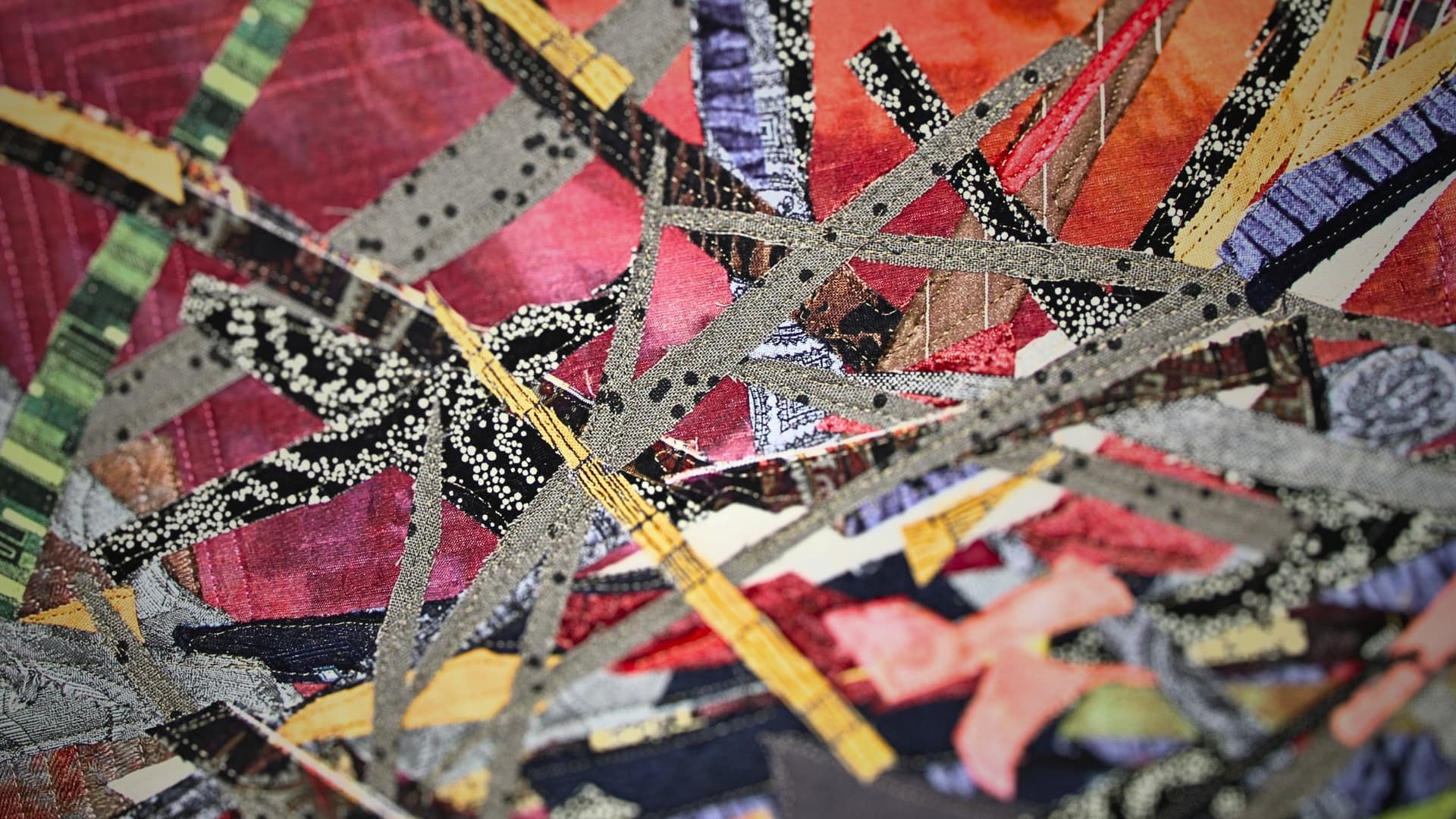
A path to self-discovery
Pat Baum Bishop: I remember drawing simple images on white fabric with a pencil and then stitching them with embroidery floss. Other embroidery projects included pillowcases and a tablecloth. I also did many crewel work pieces and counted cross stitch projects.
I begged my mother to teach me to use her sewing machine when I was 10 and started to make my own clothing.
When my children were young, I spent many years making traditional quilts. I eventually moved on to art quilting and experimenting with fabric manipulation.
Although I am mostly a self-taught artist, numerous teachers and many workshops have helped me along the way.
Laura Cater-Woods was inspirational for two reasons. Somehow, she got me to vocalise my lifelong desire to be an artist at the age of 50. Once I said it out loud, it seemed to materialise.
She also instilled in me the motto ‘do what you know, and the rest will follow’. When I was overwhelmed by too many choices, she’d say: ‘Do what you know how to do right now, and after that, you’ll figure out the next step’.
Yvonne Porcella was the first to teach me how to abstract an image. And Sue Benner also taught me different methods for creating abstract art.
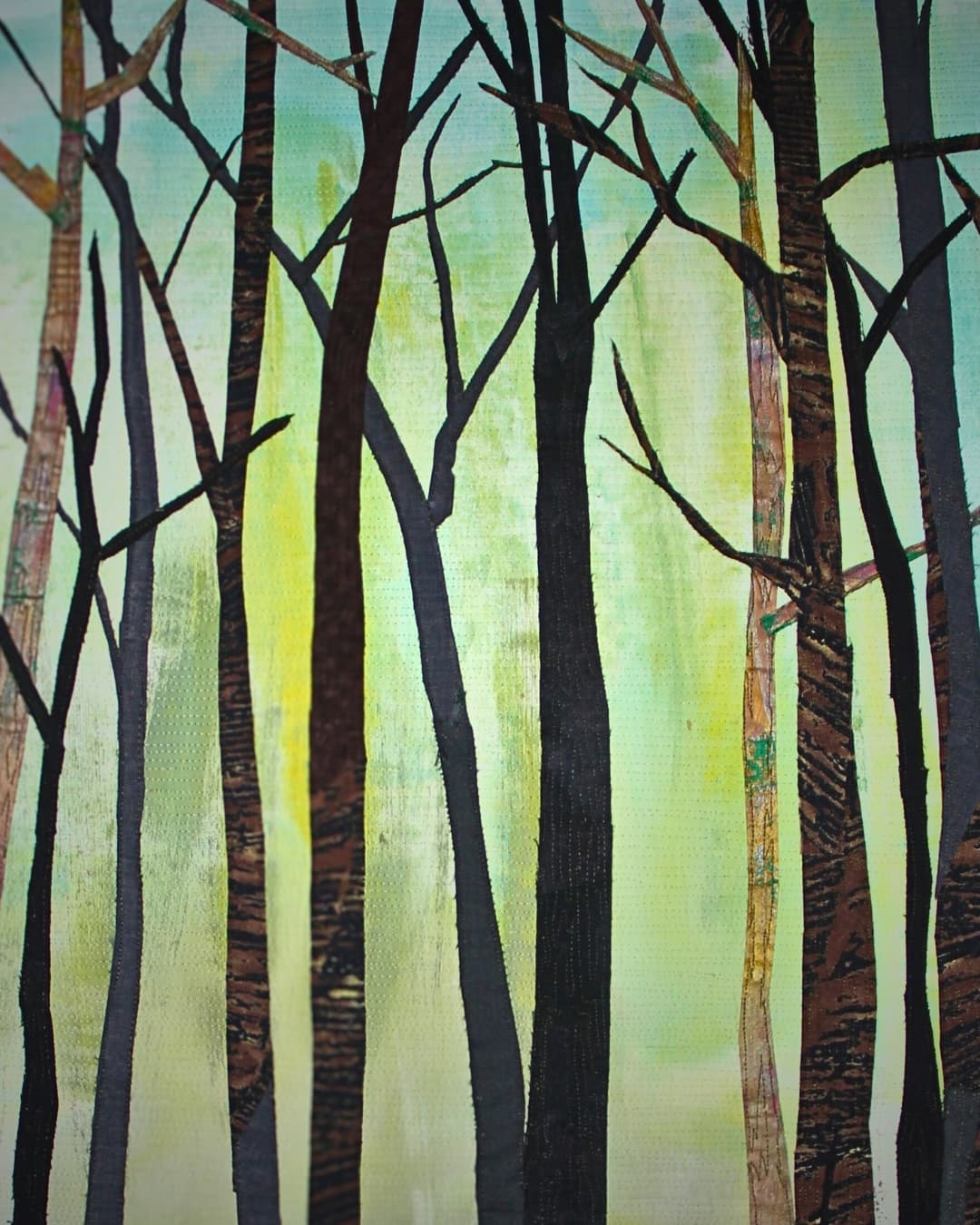
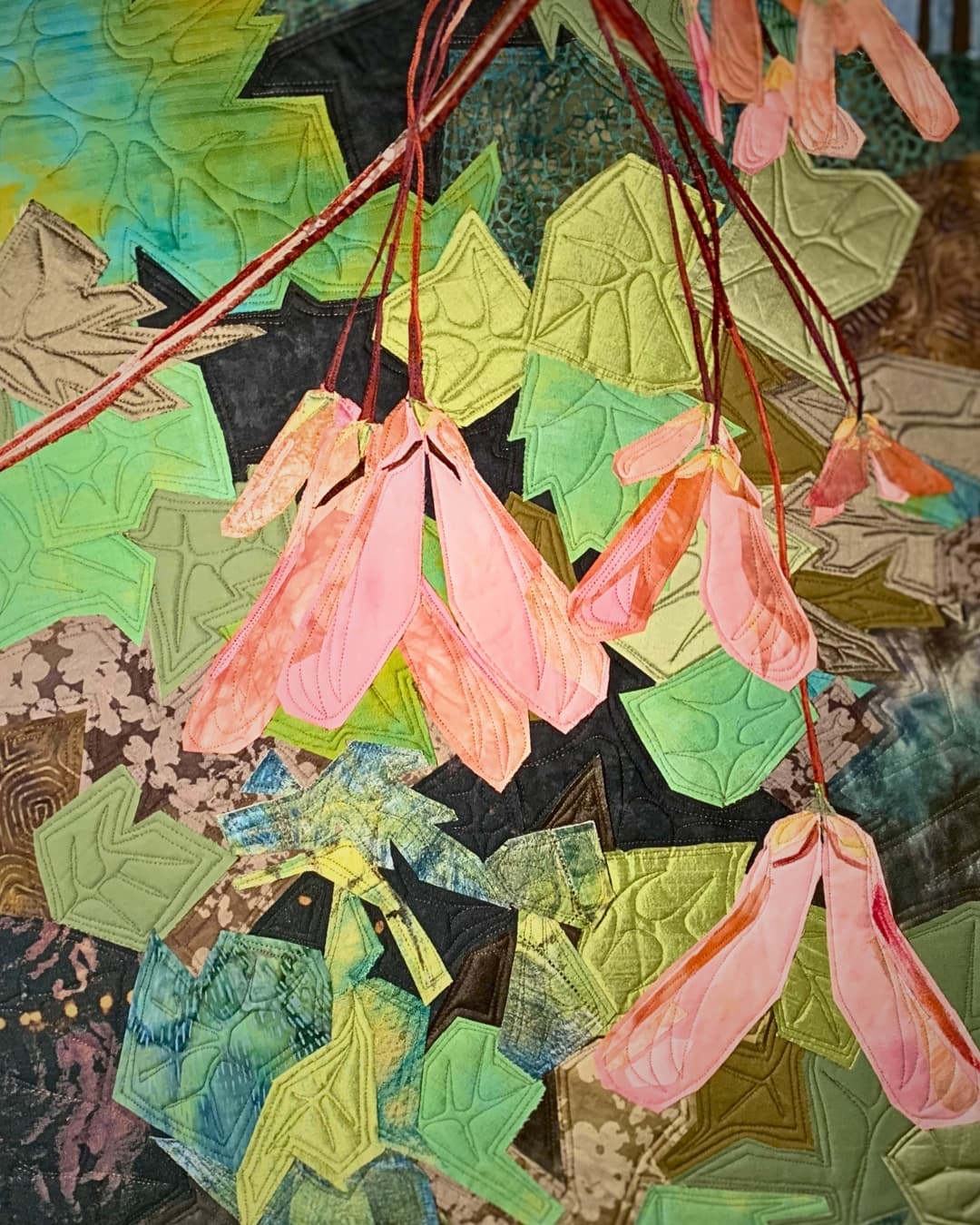
Simple abstraction
I work mostly with textiles, though I love to paint with acrylics and watercolours on paper and fabric. My love of abstraction steers my work, and my approach to abstraction is largely through simplification.
Much of my work is about preserving memories.
Lately I’ve been painting my backgrounds using watered down acrylic paint on white whole cloth fabric. I really like gradated fabric for my backgrounds, but they’re hard to find. Painting my own is even better. And it’s a very intuitive process.
During the pandemic, I took an online abstract painting class with UK instructor Louise Fletcher, cohost of the podcast Art Juice. Her class gave me confidence to play with paint, and I love it.
While most of my work is abstract, I also enjoy creating more representational work through watercolour painting on white whole cloth fabric with added machine quilting.
“Almost all my pieces have a very special meaning to me – I wouldn’t be able to do them successfully otherwise.”
Pat Baum Bishop, Textile artist
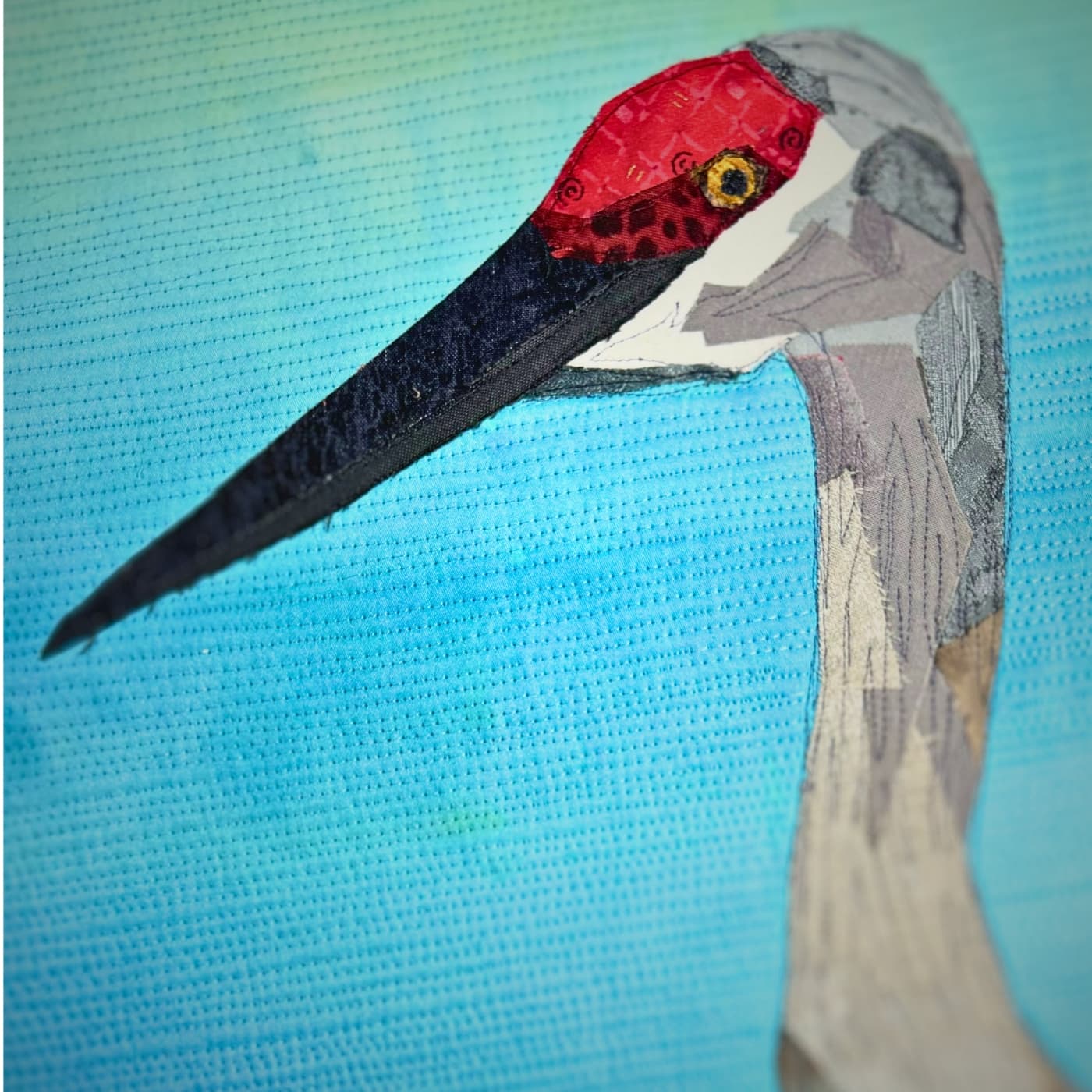
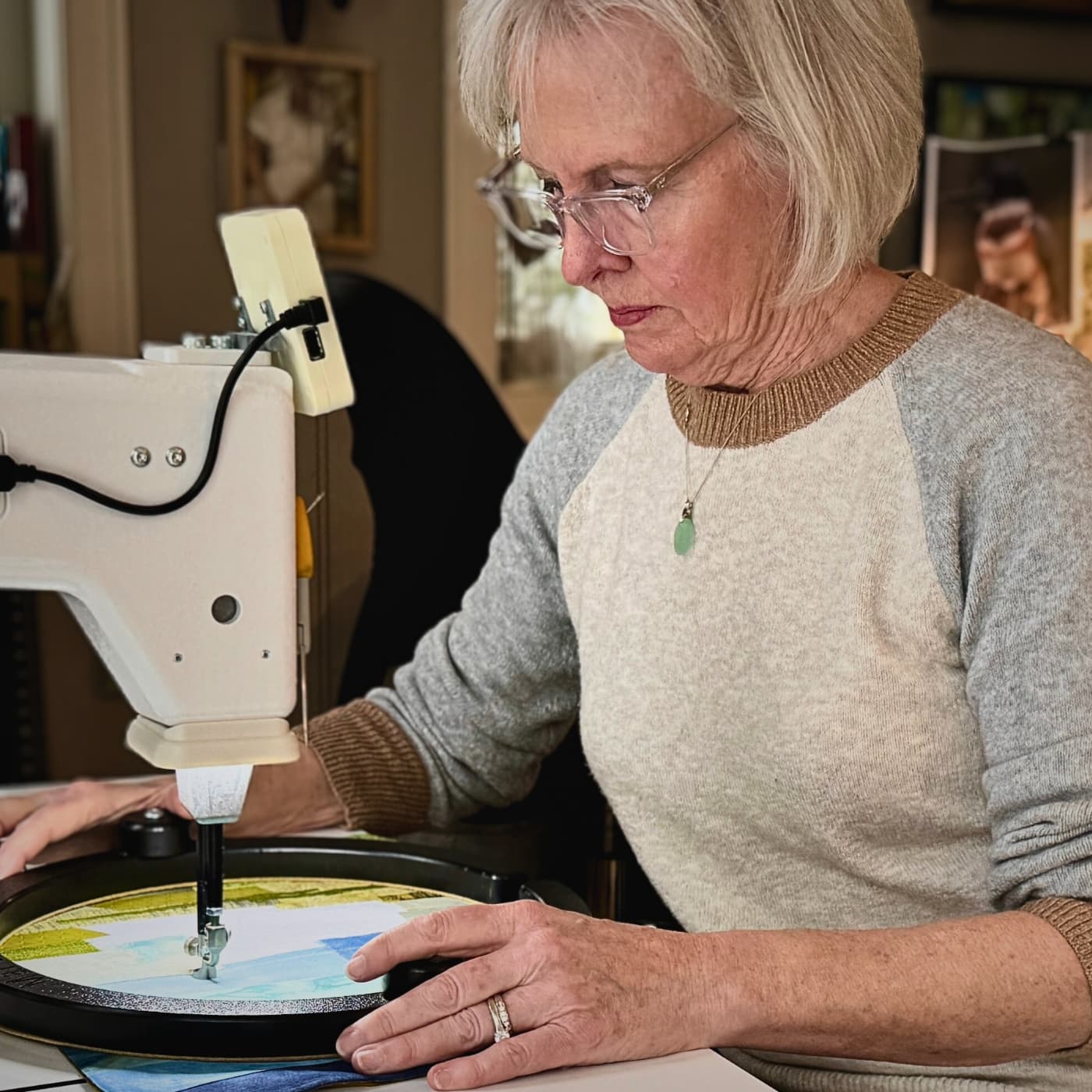
Creative process
I usually start a work with a personal photo. I sometimes use an app that converts photos into watercolour style images, called Waterlogue, which helps me see my images in a simplified view.
If I’m creating a bird or animal, some research is also involved to familiarise myself with the subject.
Starting with the photo, I see how it looks in Waterlogue. I make a very small value study, usually a Post-It note size. That study helps me determine how to work with my light, medium and dark tones.
I simplify my image, but I still don’t have everything laid out at this stage. The most planning I do is what my finished size will be, depending on if it will be bound or framed.
“I’m not one who has everything worked out ahead of time – I enjoy finding happy accidents and problem solving.”
Pat Baum Bishop, Textile artist
I work on my subject first, using a full-size cartoon that is fused to parchment paper. I always take into consideration the elements of design and composition.
After the subject is complete, I audition backgrounds by laying the fused cartoon on top of my backgrounds to see what does and doesn’t work. Once I choose the right background, I quilt it before fusing the subject on top of it.
After fusing the subject, I machine quilt it down and add any other thread painting it needs.
“My work is not perfect, and I really don’t want it to be.”
Pat Baum Bishop, Textile artist
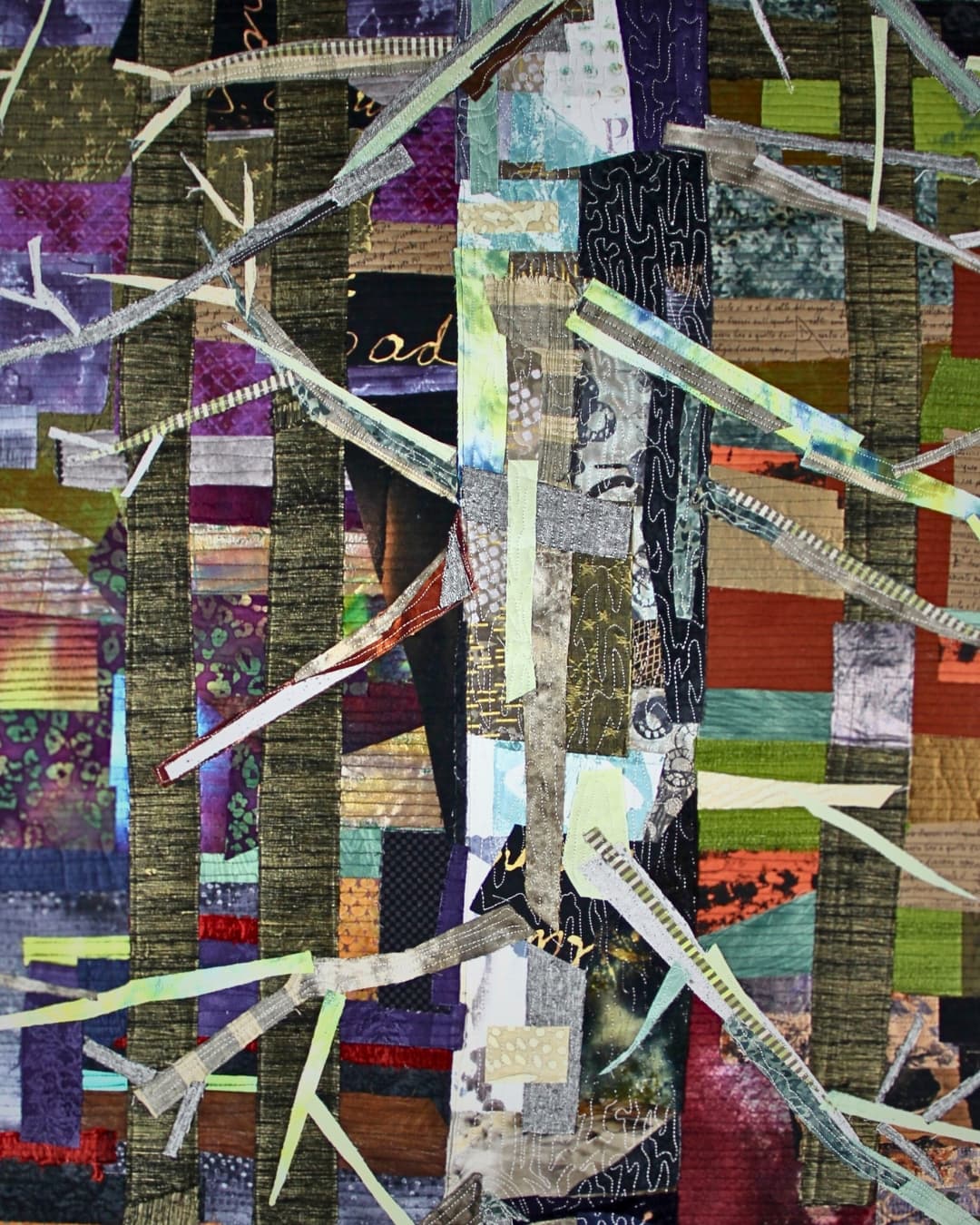
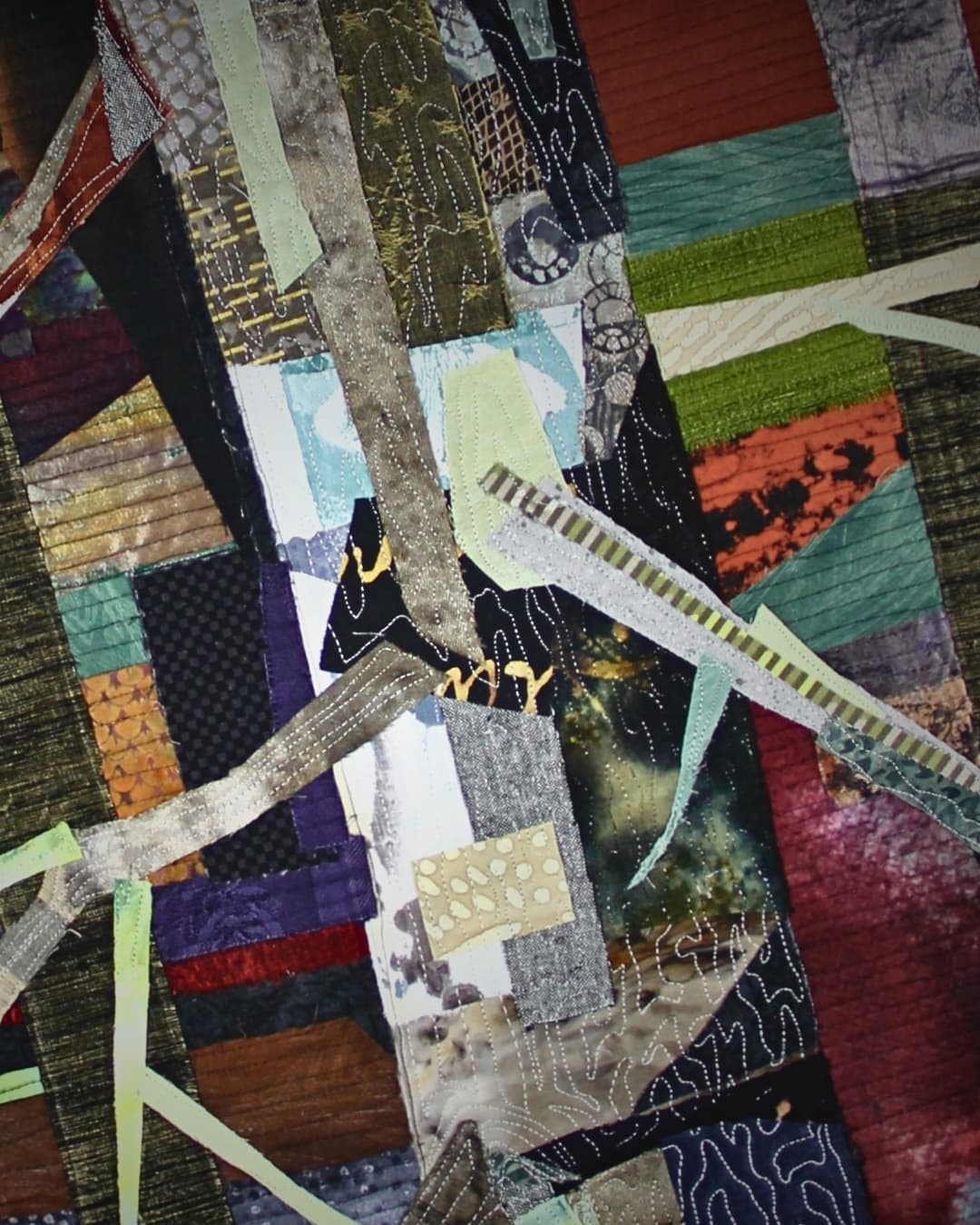
The value of imperfection
All my work is machine quilted on a sit-down Capri Handi Quilter with an 18″ throat. I don’t use a stitch regulator or rulers.
My style is somewhat cubist, and all my cuts are choppy. If I’m making any rounded cuts with my scissors, that’s a clue to myself that I’m trying too hard and it’s just not me.
Despite my quilts not being perfectly quilted, people seem to think they’re well done. I can find the flaws, but they’re not noticeable to the casual observer.
I truly believe my work is more relatable because it’s not perfect. Perfection is overrated. My work is more from the heart, if that makes sense.
A bit of advice I was given was you need to make a few ‘sacrificial’ quilts. It takes practice to get good at anything, so I made several practice quilts. You can always donate them or make them for animal shelters.
It’s also good to take breaks every 30 minutes when machine quilting.
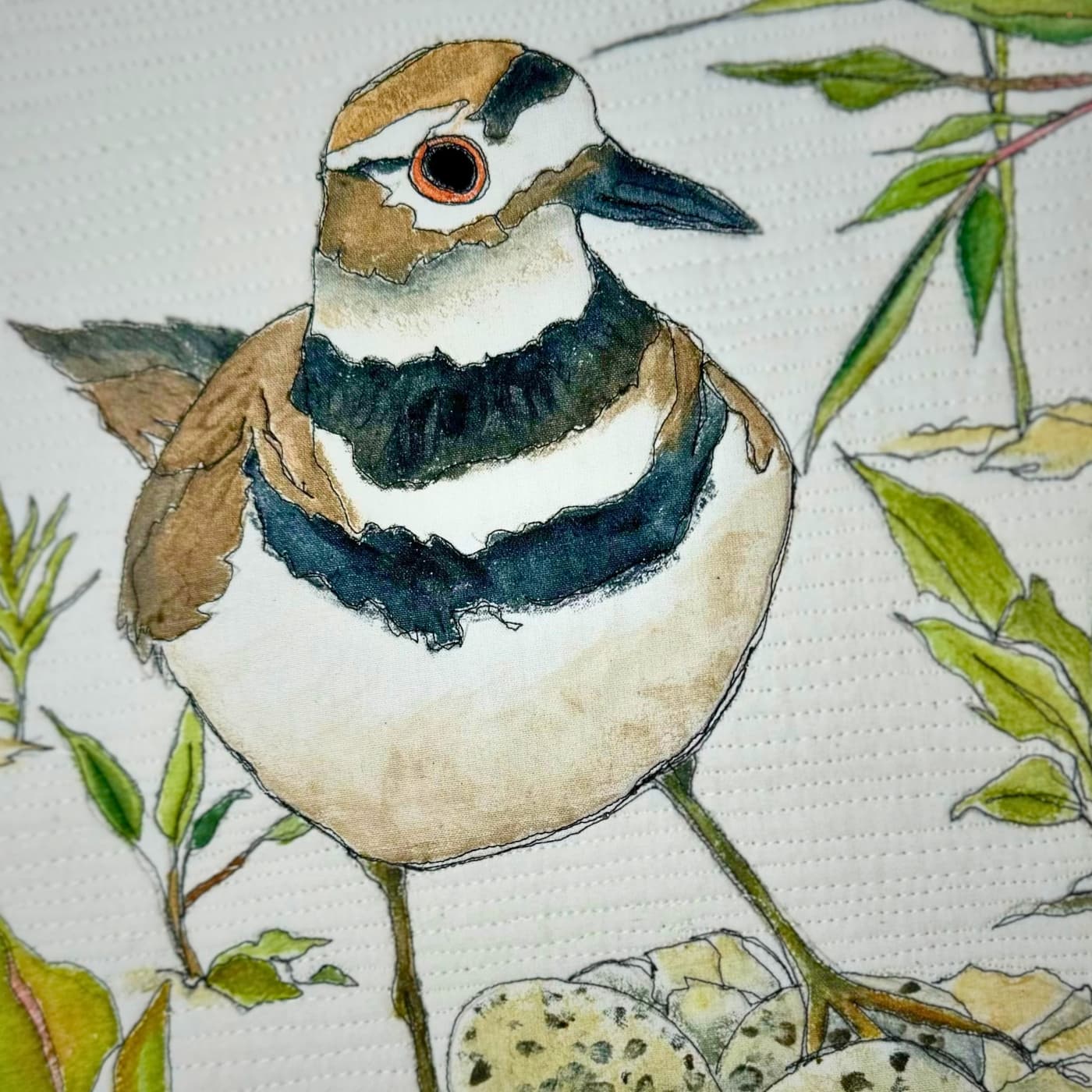
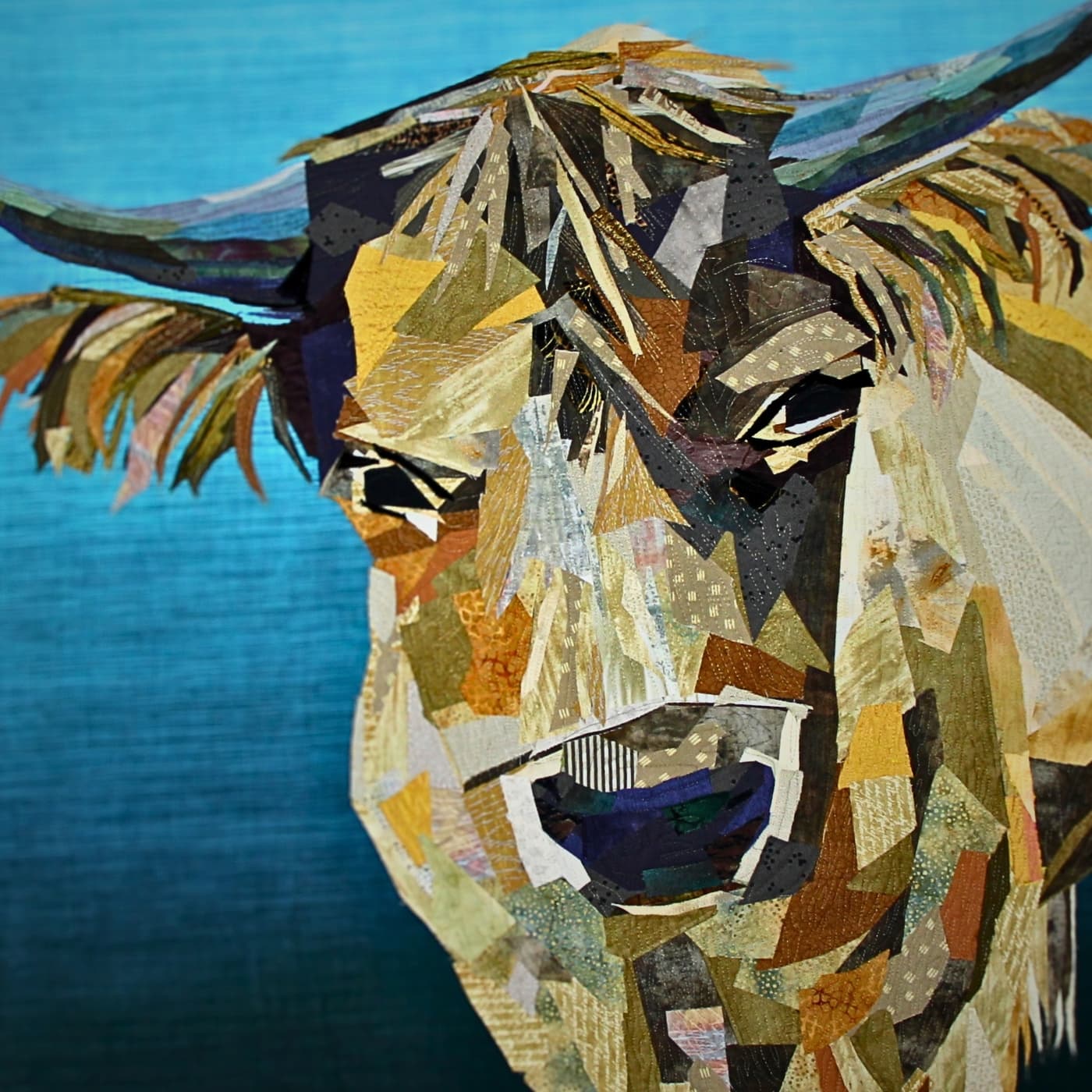
Fabrics galore
My list of potential fabric choices is long. I’ve used many different, and sometimes surprising, materials, including recycled clothing, silk, linen, damask, velveteen, denim, paper bags, men’s ties, old silk kimonos, paper towels.
As long as materials don’t melt under my iron or shred under my needle, they’re good possibilities.
I love using silk for added texture and interest, though it should mostly read as a solid colour. And my stock of hand-dyed fabrics is fairly bottomless.
I’m also an avid thrifter, though I do buy some commercial fabrics.
My fabrics are organised by colour in bookcases with sliding glass doors. Bins hold a good supply of pre-fused fabrics that are also organised by colour.
“When it comes to choosing fabrics, if it can be ironed and fused, it works.”
Pat Baum Bishop, Textile artist
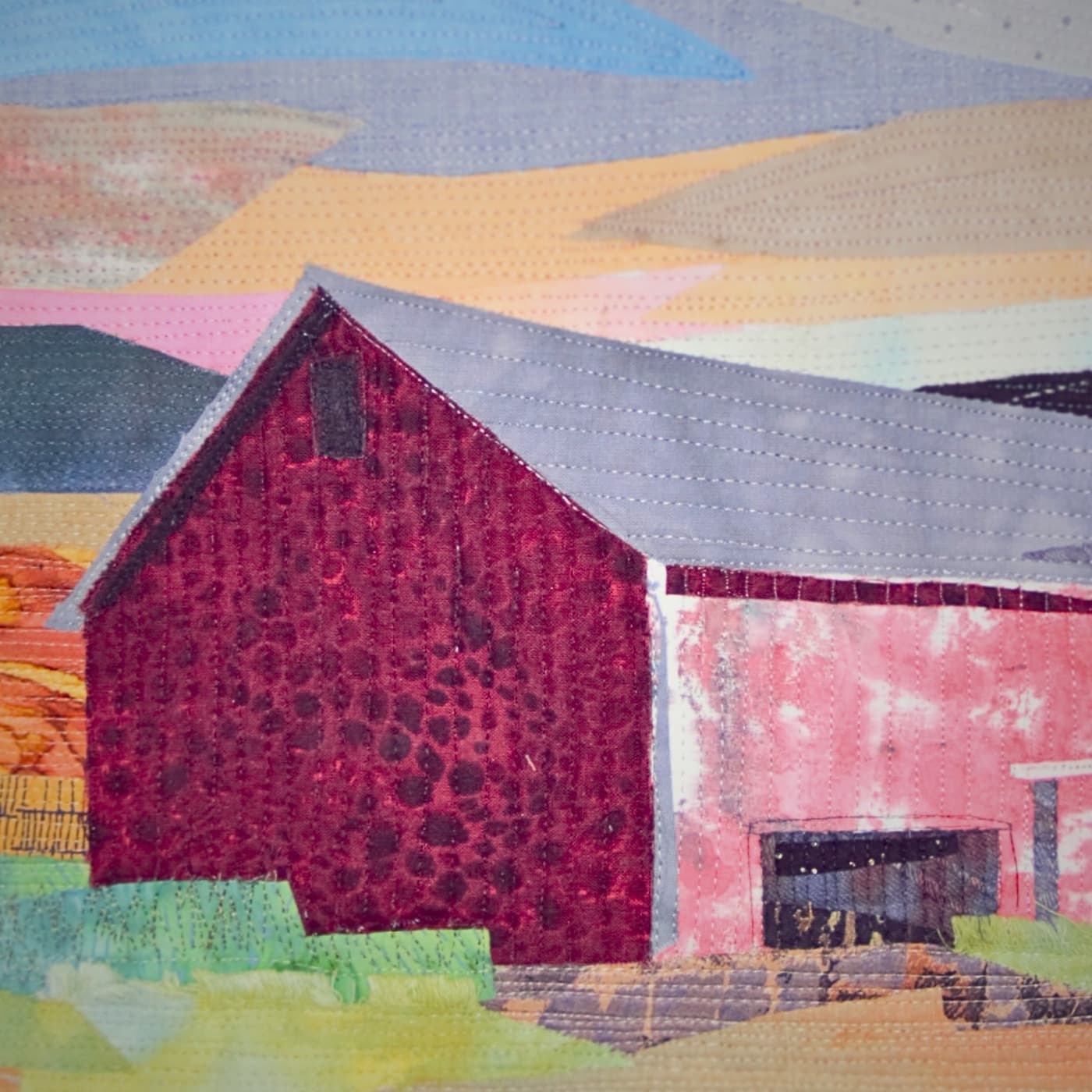
An old red barn
Red Barn looks very much like the one on my grandparents’ farm. I have so many wonderful memories of playing on the farm. Sadly, it’s no longer standing after being gobbled up by urban sprawl.
The main fabric on the light side of the barn is monoprinted. I don’t have any real plan when dyeing or printing fabric other than having fun and using colours I like. I haven’t dyed fabric for several years now, because I have so much from when I was dyeing more regularly. I dye in the summer when it can be done outside in our garage. That way it can dry in the heat of the sun.
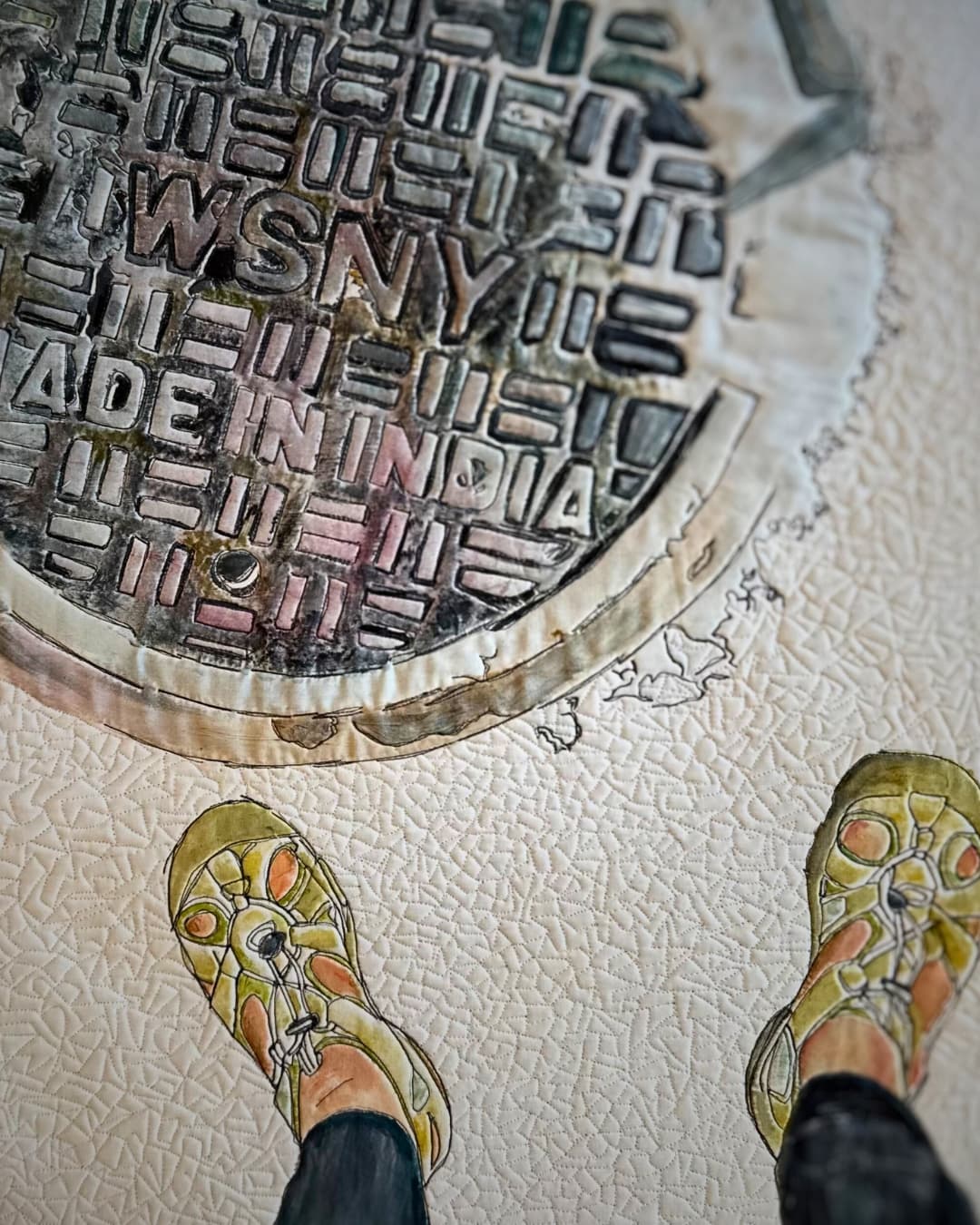
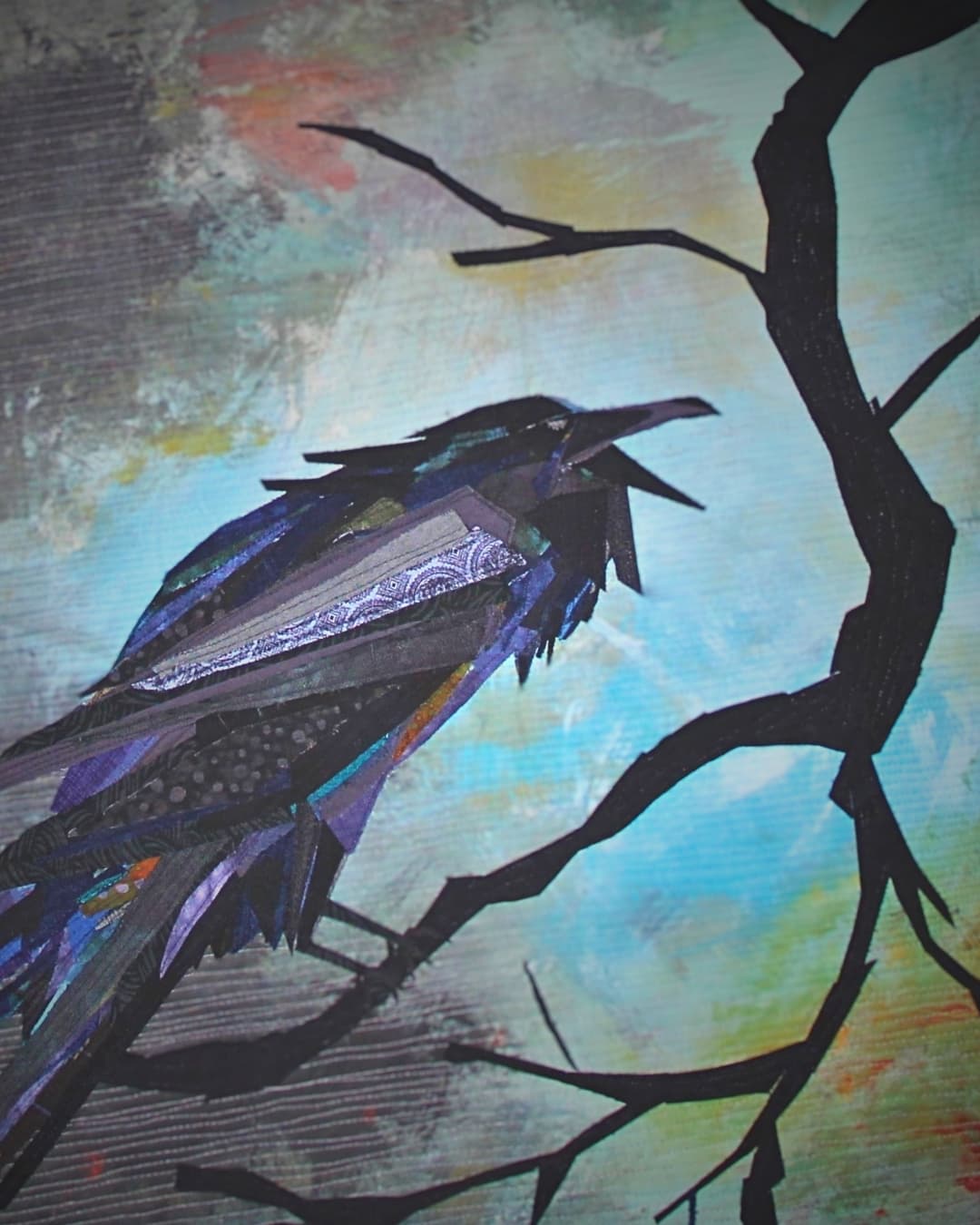
Environmental warning
Harbinger was inspired by my love of birds, but also by my worries about saving the planet. I wanted to send a message of ‘beware and be aware’ of how you live your life, as it all matters and has consequences for the earth. I felt the raven was an appropriate harbinger to send that message.
The background is hand painted in acrylics with an ominous tone. Although the raven looks mostly black, it’s actually made with many different textures of black, dark navy silk, velveteen, wovens and more.
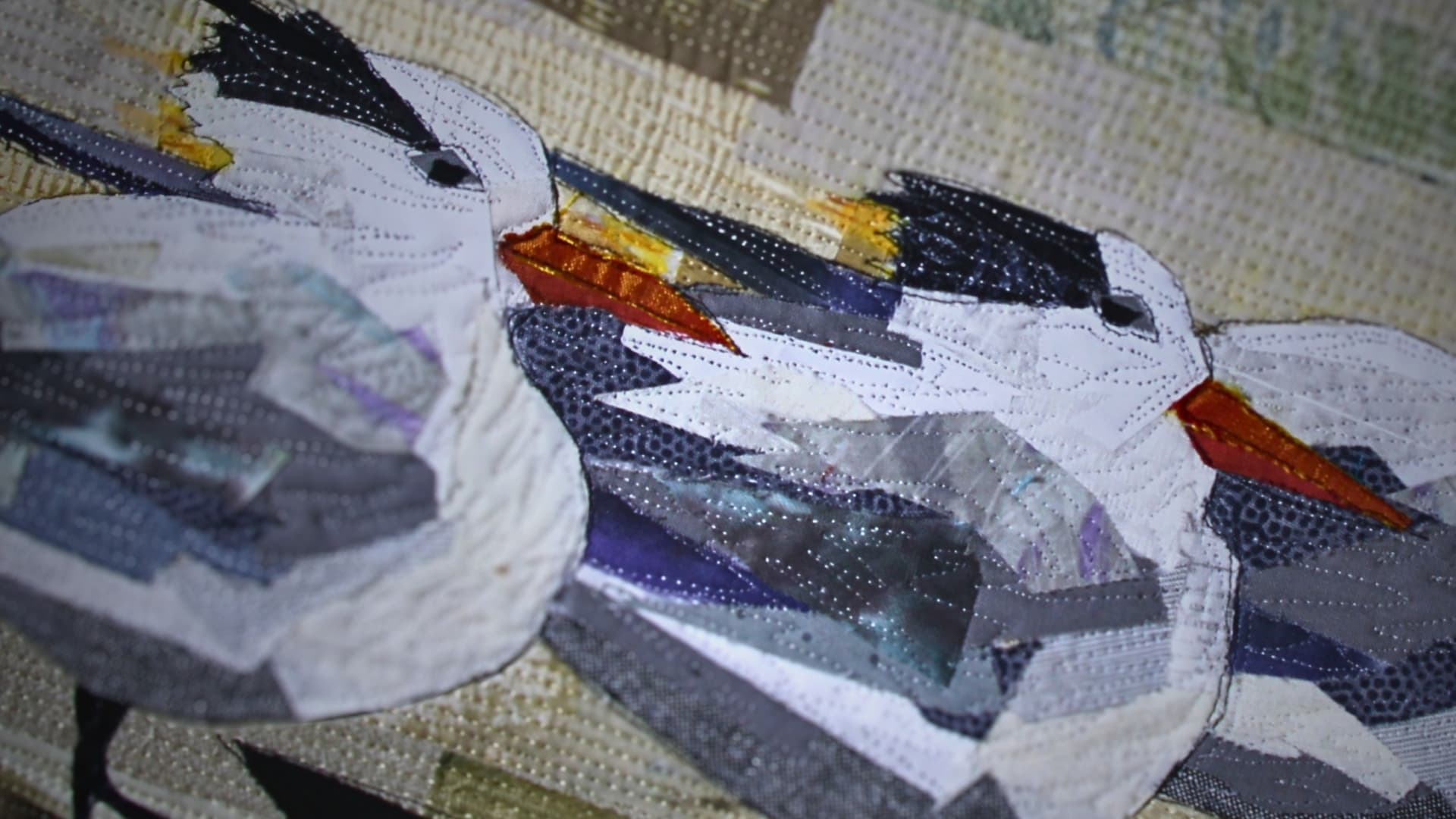
“There’s a saying ‘colour gets all the credit, but value does all the work’ – I kind of live by that rule or at least try to.”
Pat Baum Bishop, Textile artist
Contrast is more important than colour, and that is more my focus. I use colours I love and then contrast them by using light or bright against dark values. Everyone has their favorite colours. Mine are blue, especially turquoise, and there’s a lot of green in my work.
Also, when working with textiles, it’s important to take advantage of their textures – that’s a bonus you don’t see so much in other art forms. Working with fabrics that all have the same texture, or the same line of fabric, can be very boring. I suggest using a variety of textures and a range of values in fabric choices.
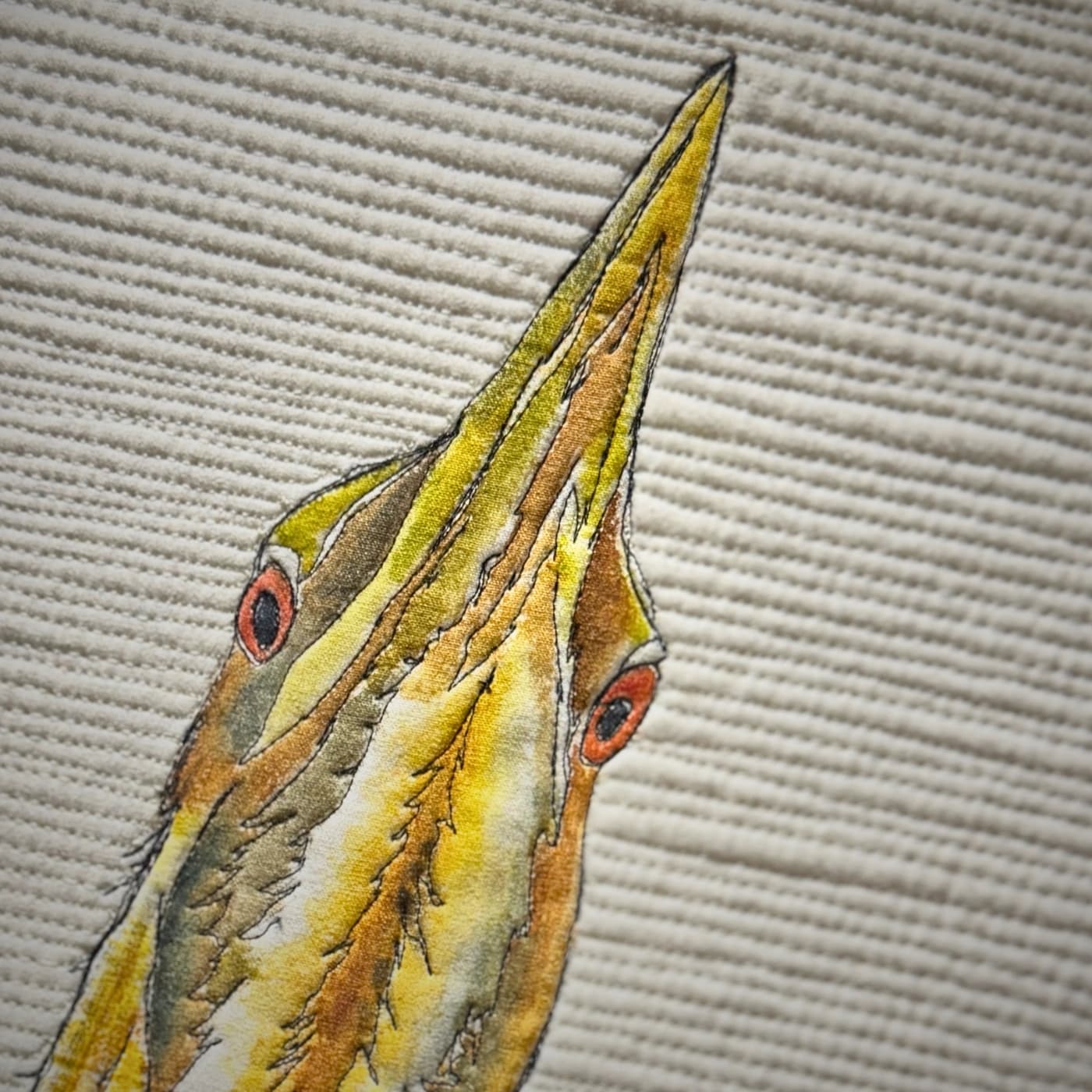
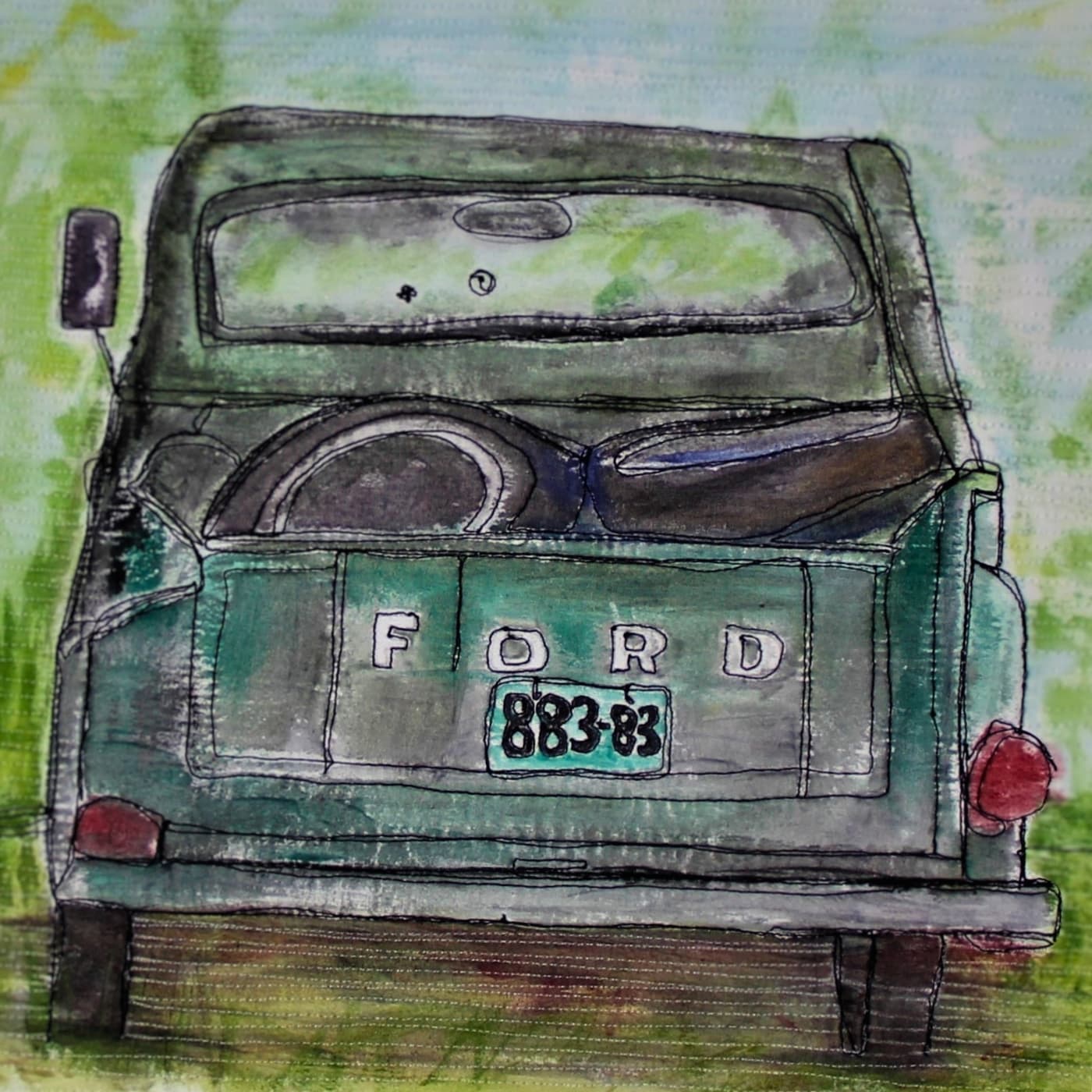
Watercolour on fabric
I painted watercolours on paper in the distant past, but within the last five years, I started up again using fabric. I had seen similar work by textile artist Donna Deaver and loved the watercolour effect.
Ford Abandoned was inspired by a photo of an old Ford truck that’s been sitting up north near our cabin. I had always wanted to do something with the image, and this was my first attempt. I’ve done many more since.
Andrew Wyeth is my favourite watercolour artist. I love the moodiness of his painting, and his settings are often farm-like. His paintings speak to me.
For my watercolour process, I draw the outline and details with pencil on tightly woven white fabric. Then I make a quilt sandwich with a backing, batting and the white fabric on top, drawn side up. I free-motion stitch the pencil drawing with black thread, not perfectly of course.
I apply a combination of watercolour paints, water and clear aloe vera gel to paint selected areas. The aloe vera gel keeps the paint and water from creeping where it doesn’t belong. The piece is then finished with additional quilting in the open large expanses.
Watercolours often have a bit of white space from the white paper background that allows the viewer to fill in the blanks and finish the story. It’s what draws you in and makes you stay and ponder what is happening in the composition. And I believe that’s why I like simplified abstract art. It allows the viewer to fill in the unfinished parts.
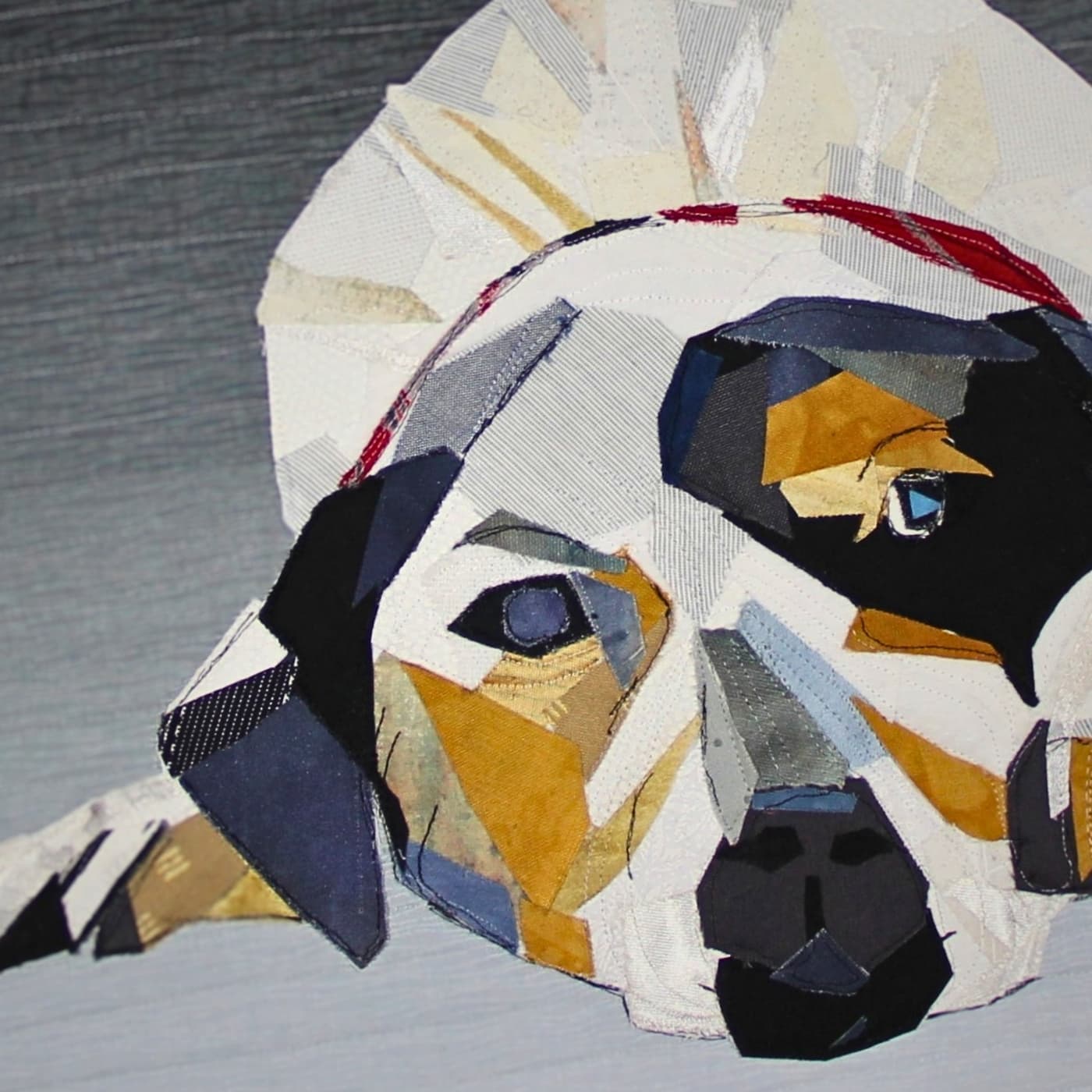
Maker’s space
My home studio is upstairs with lots of natural light and a great view of the lake we live on. It leads to a deck for reading, relaxing or just sitting.
I designed the space with a large walk-in closet to store many of my supplies. I also have a large drafting table where I work on my compositions, as opposed to a design wall. It can be tilted, and a doubled wool blanket covers at least half the table creating a large ironing surface.
It’s very adequate and I love my space. Although, since I’m doing more painting, I’d prefer having a wood floor instead of carpet. There is also a desk, TV, couch and lots of power outlets. I love my couch and my view.
I work with a Janome 6600 domestic sewing machine and a Capri 18″ throat HandiQuilter. My other must-have tools are my sharp shears and iron.
“Being away from the main living space allows for leaving a big mess, but mostly, it provides solitude.”
Pat Baum Bishop, Textile artist
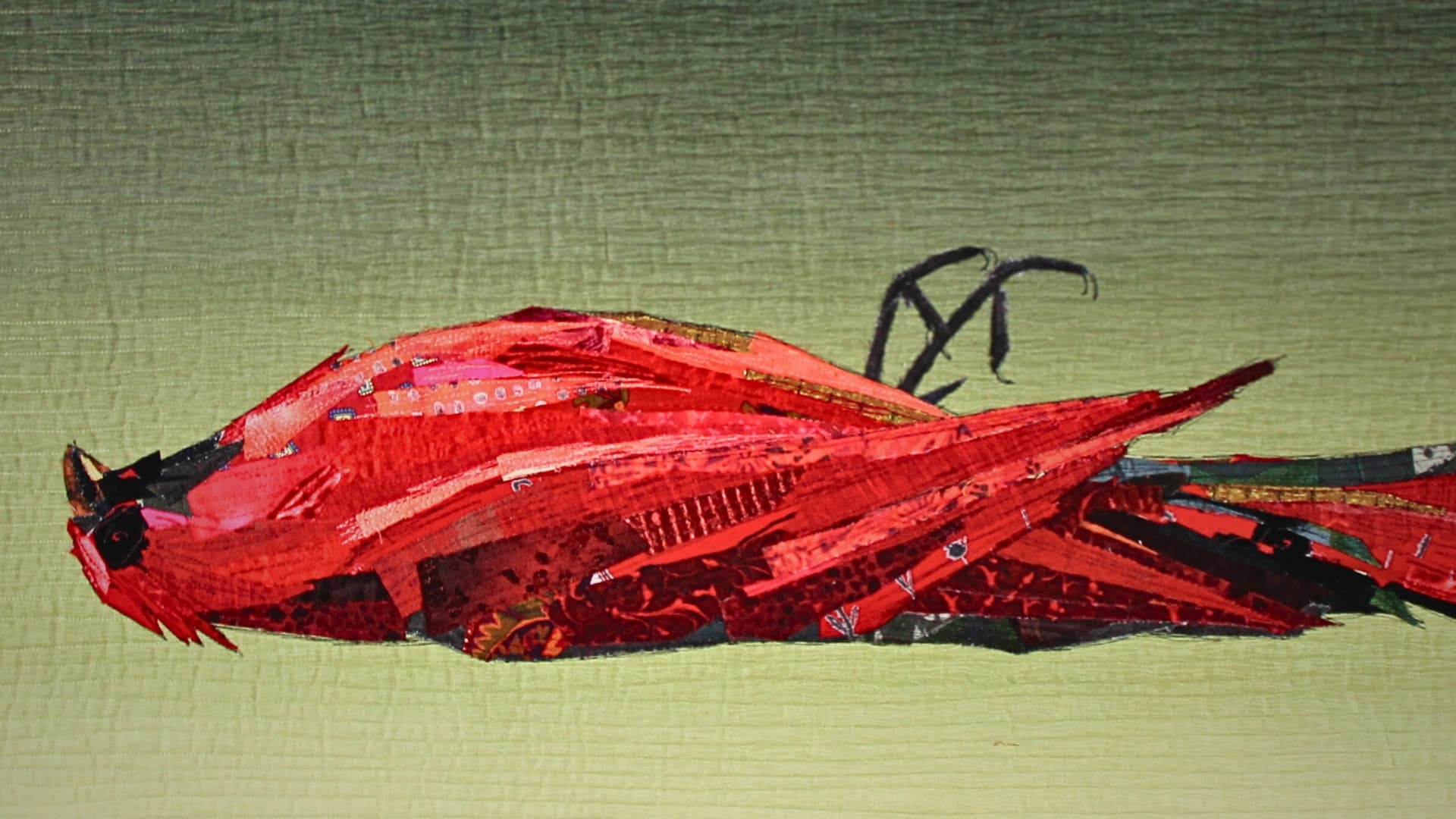
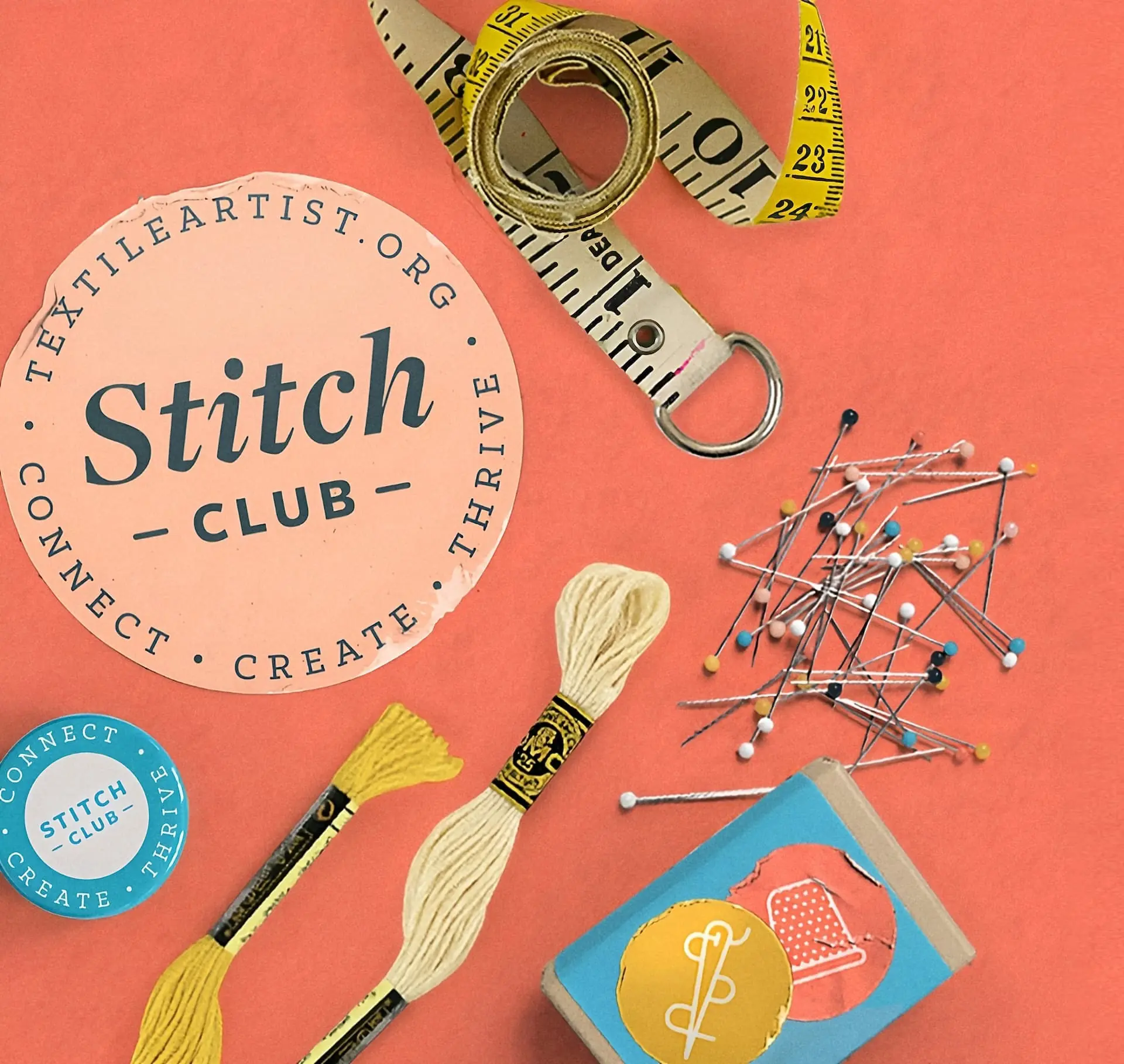
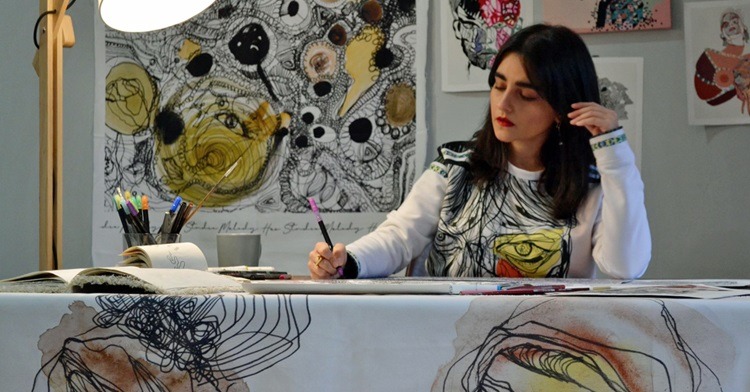
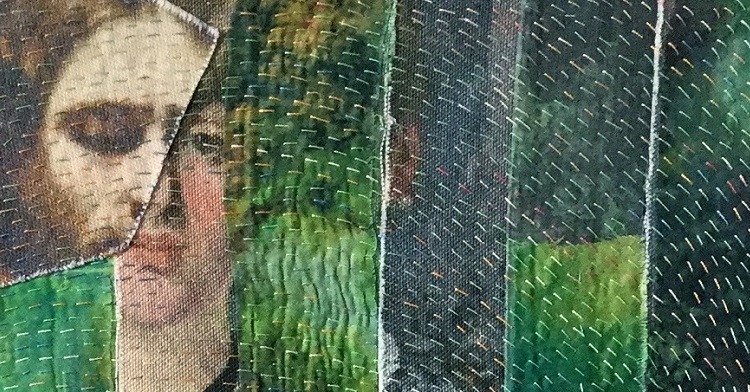
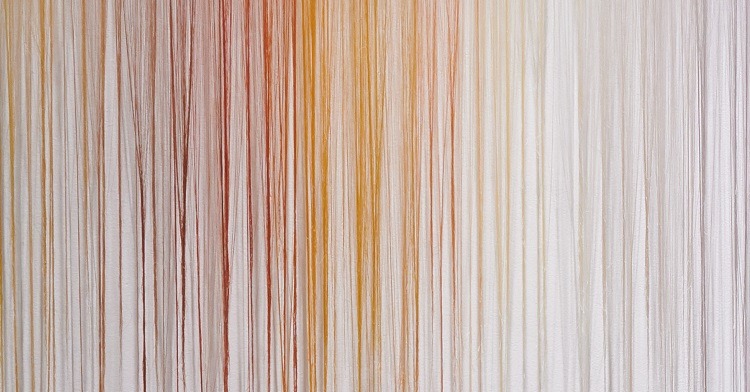
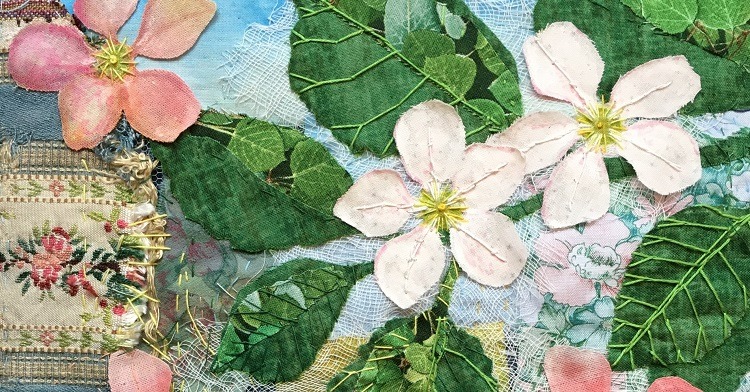
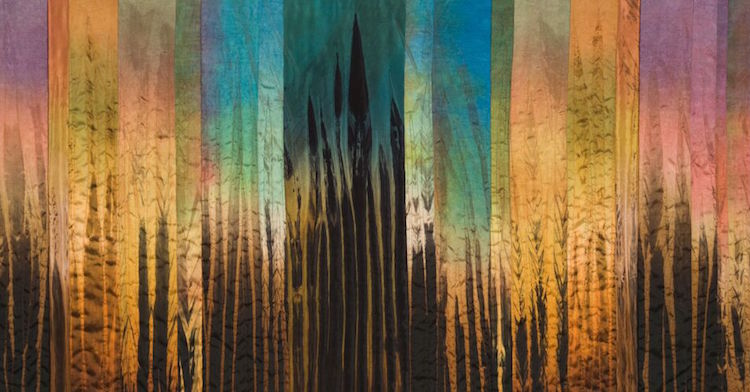
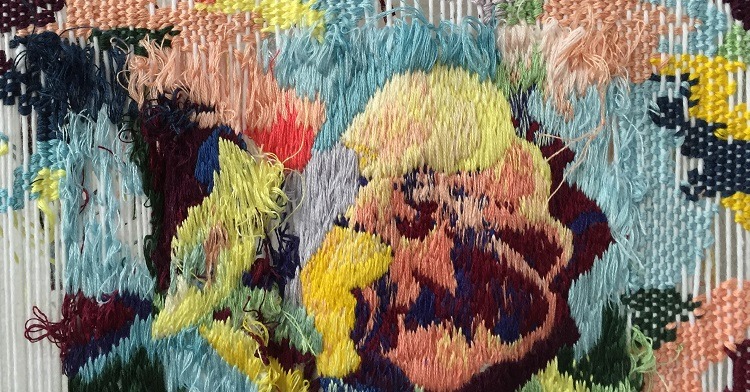
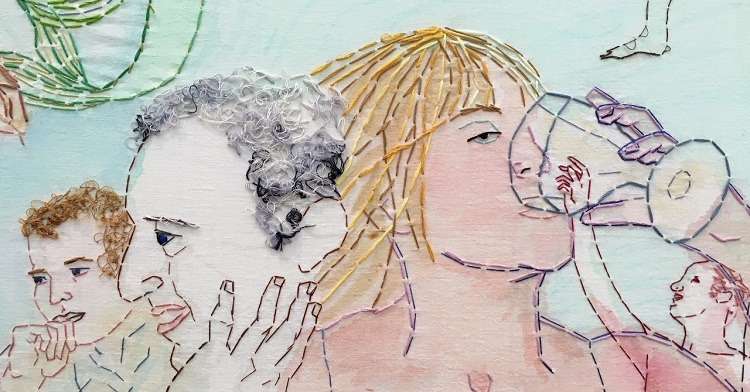
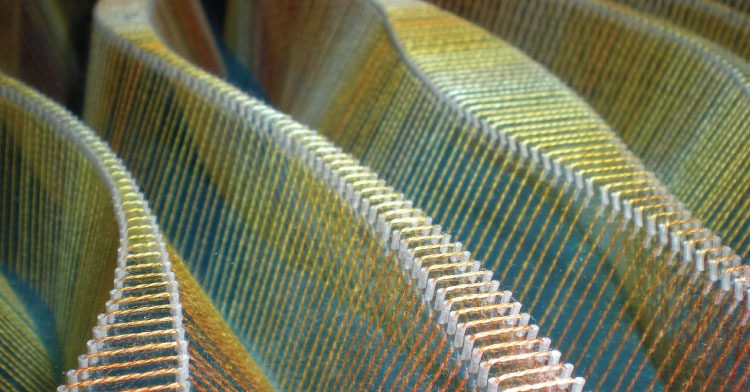
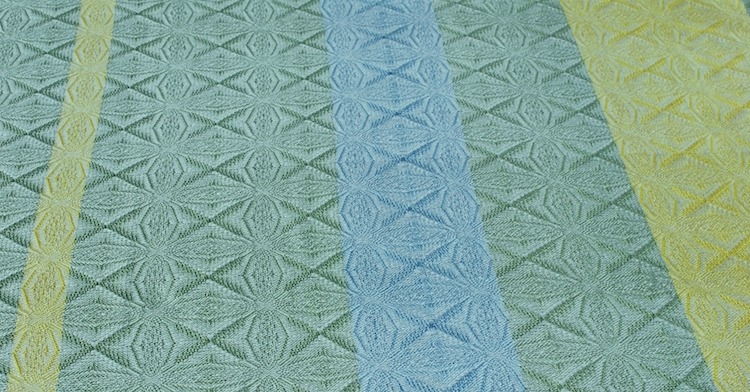
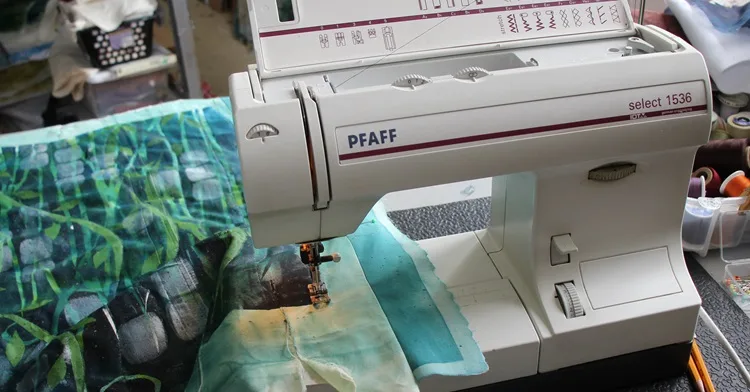
3 comments
MARIE MARTIN
INSPIRED BY COLORS, IMAGES-RED BIRD LYING DOWN AND NOTHING PERFECT…
linda brazas
I believe in “IMP Perfection”! a delightful approach to creativity with an uplifting attitude!
Siân Goff
It really is, isn’t it? Inspiring. Thanks for your comment!